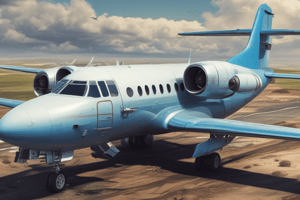Podcast
Questions and Answers
What do modern aircraft potable water systems include to ensure water quality and consumption levels are safe?
What do modern aircraft potable water systems include to ensure water quality and consumption levels are safe?
- Decorative lighting systems
- Sensors and monitoring equipment (correct)
- Artificial flavoring agents
- Water slides and fountains
Which organization sets regulations for aircraft potable water systems in the United States?
Which organization sets regulations for aircraft potable water systems in the United States?
- Environmental Protection Agency (EPA)
- Centers for Disease Control and Prevention (CDC)
- Food and Drug Administration (FDA)
- Federal Aviation Administration (FAA) (correct)
What role do aircraft potable water systems play during flights?
What role do aircraft potable water systems play during flights?
- Controlling cabin temperature
- Providing safe and reliable drinking water (correct)
- Creating entertainment shows
- Operating the landing gear
Which of the following is NOT mentioned as a potential future development for aircraft potable water systems?
Which of the following is NOT mentioned as a potential future development for aircraft potable water systems?
What do manufacturers need to comply with when designing and manufacturing aircraft water systems?
What do manufacturers need to comply with when designing and manufacturing aircraft water systems?
What are some improvements that can be expected in future aircraft potable water systems?
What are some improvements that can be expected in future aircraft potable water systems?
What is the purpose of aircraft potable water systems?
What is the purpose of aircraft potable water systems?
How have aircraft potable water systems evolved over time?
How have aircraft potable water systems evolved over time?
What was the primary use of water in early aircraft?
What was the primary use of water in early aircraft?
What do modern integrated water management systems in aircraft do?
What do modern integrated water management systems in aircraft do?
What purpose do emergency water systems on aircraft serve?
What purpose do emergency water systems on aircraft serve?
What happens to collected water in modern aircraft potable water systems before storage?
What happens to collected water in modern aircraft potable water systems before storage?
Flashcards are hidden until you start studying
Study Notes
Aircraft Potable Water Systems
Aircraft potable water systems provide drinking water to passengers and crew members during flights. These systems have evolved significantly over time, from basic containerized water storage units to more advanced integrated water management systems that monitor water quality and consumption rates. Here's an overview of how these systems work and their evolution through history:
Early Containers and Holding Tanks
Early aircraft used simple containers filled with bottled water or other portable containers for storing water. This water was typically used for hand washing and bathroom facilities. As flight times increased and passenger numbers grew, so did the need for more efficient ways to manage water supplies onboard.
Integrated Water Management Systems
Today, many modern aircraft feature integrated water management systems that incorporate both pre-flight and in-flight processes for water collection, treatment, and distribution. These systems can collect rainwater and condensation from the air conditioning system, as well as wastewater from sinks and lavatories. The collected water undergoes filtration and sterilization processes before being stored in potable water tanks for later use.
Emergency Water Systems
In addition to regular potable water systems, some aircraft carry emergency water systems designed to keep passengers hydrated if the plane crashes into water and has to float until it can be rescued. These systems include lifeboats equipped with fresh water and food provisions, such as MREs (Meals Ready to Eat).
Monitoring Consumption and Quality
Modern aircraft potable water systems include sensors and monitoring equipment to ensure water quality and consumption levels are within safe standards. These systems help maintain optimal water temperature and pressure, reduce the risk of bacterial growth, and prevent contamination incidents.
Regulations and Certification
International organizations like the Federal Aviation Administration (FAA) in the United States set regulations for aircraft potable water systems to ensure they meet certain safety requirements. Manufacturers must comply with these regulations when designing and manufacturing aircraft water systems.
Future Developments
As technology continues to evolve, we can expect improvements to aircraft potable water systems that further enhance efficiency, reliability, and sustainability. This may include advances in water filtering technologies, energy recovery mechanisms, and more sophisticated control systems to optimize water usage and minimize waste.
In summary, aircraft potable water systems play a crucial role in providing safe and reliable drinking water to passengers and crew members during flights. From early containerized systems to today's advanced integrated water management systems, these systems have come a long way and will continue to evolve in the future.
Studying That Suits You
Use AI to generate personalized quizzes and flashcards to suit your learning preferences.



